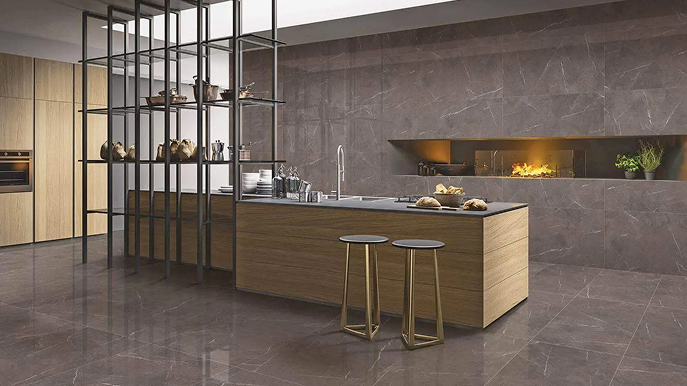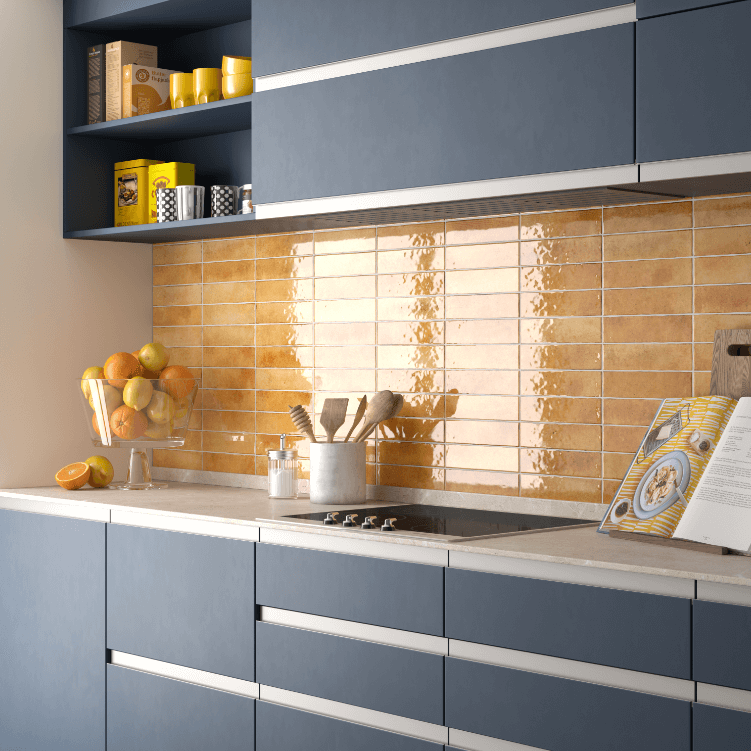Tiles serve many purposes in both functionality and aesthetics, acting as essential elements for waterproofing while also offering the opportunity to enhance a space with colour, texture, and pattern. The way tiles are laid out can significantly influence the overall ambience and style of a room, making the choice of pattern a crucial aspect of design for anyone considering home improvements, renovations, or DIY projects.
Why Tile Patterns Are Crucial
The decision to select a specific tile pattern is not just about aesthetics but involves strategic thinking. The right pattern can alter the perception of space, making rooms appear larger or more cohesive, and can accentuate architectural features, improving the distribution of natural light or emphasising particular areas of your space. Additionally, certain patterns can offer functional benefits like increased slip resistance or easier maintenance, making them ideal for your bathroom.
Considerations for Room Size & Shape
The size and layout of a room are significant factors in selecting a tile pattern. Large patterns might overwhelm small spaces, but they can add a striking design element to larger rooms. For smaller rooms, patterns that create an illusion of space, such as diagonal layouts, are beneficial. Patterns like the straight lay are adaptable and can work well in rooms with unique shapes or many corners, maintaining a consistent look without adding complexity.
Impact of Tile Size & Shape
The physical attributes of tiles — including size, shape, and thickness — play a key role in determining the possible patterns. Large-format tiles are suited to bigger areas or when a seamless look with fewer grout lines is desired, though they may not be practical for smaller rooms. Smaller tiles or those with distinctive shapes offer more pattern choices and can adapt more easily to rooms with irregular shapes.
Achieving the Desired Style & Ambience

The chosen tile pattern should align with the intended aesthetic of the space. Simple patterns like straight or diagonal lays can suit a modern, minimalist look without overwhelming other design elements. For a more traditional or rustic feel, patterns such as basket weave or herringbone add texture and depth. Bold patterns, like chevrons or mosaics, can act as a focal point, adding visual interest and reflecting style.
Functionality Considerations
In high-traffic areas such as kitchens, selecting a pattern that can hide dirt and wear while being easy to maintain is essential. Some patterns, especially those with more grout lines, may offer better slip resistance but could require more effort to keep clean. The choice should balance aesthetic appeal with the practical aspects of maintenance and durability, especially in spaces used daily.
Popular Tile Laying Patterns
Tile laying patterns can transform the selection of tiles into a dynamic element of room design, serving as a key design feature that affects atmosphere, spatial perception, and aesthetic appeal. From the simplicity and elegance of straight lay to the dynamic appearance of diagonal lay and the classic sophistication of herringbone, each pattern offers a unique way to enhance a space.
Step Ladder
The Step Ladder pattern arranges tiles in a sequence that mimics steps, creating a rhythmic and geometric aesthetic. This unique layout adds depth and interest to floors or walls, making spaces appear more dynamic. It’s particularly effective in areas where a strong, graphic statement is desired.
Diagonal Herringbone
Tiles are laid at a 45-degree angle to the floor or wall, creating a pattern that points diagonally, offering a more dynamic and visually captivating version of the traditional herringbone. This pattern adds a sense of movement and can make spaces feel more vibrant and energetic. It’s ideal for adding a sophisticated touch to both traditional and contemporary interiors.
Assorted Sizes & Shapes
Combining tiles of different sizes and shapes introduces a playful and eclectic mix into the space, offering endless creative possibilities. This approach can create a bespoke, artisanal look that adds character and depth. It works well in spaces that aim to be unique and personalised, blending various textures and colours for a rich tapestry.
Assorted Colours
Integrating tiles in random colours can inject playful energy and vibrancy into a room, creating a mosaic-like effect that stands out as a focal point. This pattern is perfect for spaces that benefit from a splash of colour and creativity, encouraging a lively and dynamic ambience. It allows for personal expression and can make the space truly one-of-a-kind.
Alternating Vertical Stacking
Tiles are stacked vertically, but each row is alternated to add a subtle twist to the classic vertical stack. This pattern elongates walls, making ceilings appear higher, and introduces a rhythm without overwhelming the space. It’s a sleek choice for modern bathrooms or kitchens, offering a fresh take on a straightforward design.
Chevron Pattern
The chevron pattern, with its V-shaped repetition, creates a dynamic and elegant flow that leads the eye across the space. This sophisticated pattern adds a sense of luxury and depth, making it a popular choice for floors and accent walls. It works beautifully in both contemporary and traditional settings, adding a structured yet playful element.
Zig Zag Herringbone
Tiles are laid out at right angles to form a zigzag pattern that runs horizontally across the surface, offering a contemporary twist on the classic herringbone. This layout adds texture and visual interest to a space, making it feel wider and more open. It’s an excellent choice for backsplashes or feature walls where a subtle yet impactful design is desired.
French Pattern
The French pattern combines tiles of various sizes to create a patchwork effect, offering a rustic and timeless appeal. This layout is often used with stone tiles to enhance natural variations in colour and texture, creating a warm and inviting atmosphere. It’s ideal for floors in living areas, or outdoor spaces such as patios and pathways, adding a touch of old-world charm.
Staggered Bond
Tiles are laid in rows, with each row offset from the one before, creating a staggered, brick-like effect. This pattern is versatile, working well in both contemporary and traditional spaces, and can help to hide imperfections in walls or floors. It’s particularly effective in bathrooms and kitchens, adding texture and interest without overwhelming the space.
Vertical Offset
Tiles are laid vertically in an offset pattern, similar to the staggered bond but oriented upward, elongating the appearance of walls and making spaces feel taller. This pattern can add a contemporary twist to the classic brick layout, bringing a sense of height and openness. It’s ideal for small bathrooms or narrow spaces, maximising the perception of space.
Horizontal Stacking
Horizontal stacking features tiles laid directly on top of each other in straight, horizontal rows, offering a clean, contemporary look. This pattern emphasises the width of a space, creating a visually expansive effect that’s perfect for modern interiors. It’s particularly effective with large-format tiles for a seamless appearance.
Diagonal Brick Bond
Tiles are laid at a 45-degree angle in a brick bond pattern, adding a dynamic twist to the traditional brick layout. This approach infuses spaces with energy and movement, making it a striking choice for feature walls or floors. It’s a bold pattern that can serve as the centrepiece of a room’s design.
Vertical Stacking
Vertical stacking arranges tiles straight up and down, creating clean lines that can make ceilings appear higher. This pattern is sleek and straightforward, ideal for creating a modern and minimalist aesthetic. It works well in bathrooms and kitchens, offering a fresh and orderly appearance.
Cross Hatching
Tiles are laid to form a crosshatch pattern, creating a grid-like appearance that offers visual interest and geometric precision. This pattern adds a structured and orderly feel to spaces, suitable for areas that benefit from a subtle, yet distinct, design element. It’s a versatile choice that can complement both contemporary and traditional decors.
Mosaic Patterns
Mosaic tiles come in small pieces, often assembled on a mesh sheet, allowing for intricate designs and patterns. Laying mosaic tiles can add detailed artwork to floors and walls, offering limitless possibilities for personalisation and creativity. This technique is perfect for creating focal points in bathrooms, kitchens, or as decorative borders.
Double Herringbone
The double herringbone pattern takes the classic herringbone layout and doubles up each row of tiles, creating a thicker, more pronounced zigzag. This variation adds depth and texture to the surface, making it a standout feature in any room. It’s a sophisticated choice for floors and walls, offering a more intricate take on the traditional herringbone pattern.
Selecting the Right Pattern for Your Space

Choosing the appropriate tile pattern is a critical design decision that influences the room’s overall look and feel. This process involves considering how the pattern interacts with the room’s dimensions, lighting, and existing décor to create a cohesive and attractive environment. A well-chosen tile pattern can make a living space appear larger, brighter, and more inviting, adding depth and interest or serving as a striking design statement.
The Strategic Art of Tile Patterns
Tile patterns play a vital role in interior design, offering the opportunity to elevate a space through careful selection and application. Whether aiming for a subtle background or a bold statement piece, understanding and utilising tile patterns can unlock the full potential of your design vision, enhancing both the functionality and aesthetic appeal of your space.
 Shop by type
Shop by type
 Shop by type
Shop by type
![]() BATHROOMWARE
BATHROOMWARE


